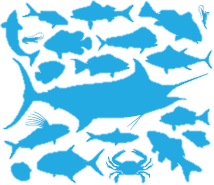It is essential to carefully interpret the results of stock assessments, so that the management actions are based on the most accurate possible understanding of the status of the fishery. First of all, it is critical to review how sampling was conducted and to understand all the factors that could influence the patterns you are observing in the data. Second, careful interpretation of the results of each assessment is necessary to increase confidence that the outputs are accurate and not confounded by other variables. Finally, multiple assessment methods using independent streams of data (fishery dependent as well as fishery-independent) should be examined together to see if they corroborate one another or are in conflict. If your assessment results show that all of the performance indicators (PIs) are at target reference point (RP) levels, the Harvest Control Rule (HCR) created at Step 8 might be to simply maintain current harvest levels. However, because fisheries are complex and many factors can influence the levels of performance indicators, sometimes the indicator levels may conflict with each other, so they require some interpretation.
For example, if the two PIs selected are CPUE and the MPA Density Ratio, and completion of some of the assessment methods discussed at Steps 5 and 9 reveal that CPUE is at its target RP (suggesting that stock abundance and profits may be high) but the MPA density ratio is below its limit (suggesting that stock abundance may be low), it will not be immediately clear what the appropriate management action should be. Consulting with fishermen may reveal that CPUE is high because (for example) a new patch of fish has recently been discovered, or because they have improved their targeting methods. The most plausible interpretation of the CPUE and MPA density ratio indicator levels might then be that overall stock abundance has in fact declined below target levels, but that fishermen are maintaining high CPUE because they have become more skillful in finding fish. If this is the case, then the HCR should dictate a reduction in fishing mortality in order to rebuild the stock to target levels.
To give another example, the results of length-based assessment methods such as catch curve or SPR could indicate that fishing mortality or SPR exceeds the relevant RP based on a high proportion of small fish in the catch, while the MPA Density Ratio result meets its RP, indicating the stock is at desired abundance levels. In this case, fishermen may be targeting smaller fish or there may have been a recent recruitment pulse resulting in a particularly strong cohort that has become available to the fishery, meaning that the length-based methods are overestimating fishing mortality and the stock is in fact in good health. Thus, it is critical that traditional, local, and expert knowledge of the fishery be consulted when interpreting the results of data limited assessments, both to increase buy-in to the results which will drive management and to ensure that the interpretations of indicator levels relative to RPs are as accurate as possible.
Another major factor that must be considered when interpreting the results of stock assessments is the impact of climate change on the system. In some cases, the dynamics identified through the assessments (e.g., declining abundance, low SPR, etc.) might be the result of climate change-driven system changes rather than the level of fishing, or (more often) the result of a combination of these two drivers. The task of teasing apart the specific stock changes that are driven by climate change from those driven by the fishery is extremely complex, and not likely to be within reach of most data-limited fisheries. In fact, this type of scientific precision is often beyond the reach of the most complex and sophisticated fishery management regimes. However, knowing the exact proportions of a change that can be attributed to climate change and to fishing pressure is not necessary to making effective, climate-smart management decisions. It is only necessary to consider whether or not climate change might be having an impact on a stock or system, to understand in what way that impact is likely to manifest (e.g., the stock range might change, the productivity might decline, or new stocks might move into the area), and to refer back to the participatorily-developed climate resilience goals that stakeholders set for your fishery system in Step 2.
As discussed at Steps 6 and 7, interpretation of assessment results in a multispecies fishery where management baskets are in use requires additional caution. For each assessment conducted on the representative species, it is necessary to ask the question “Does this result make sense for all the stocks in this basket?” If the answer to this question is not readily known, it may be necessary to consult with the fishermen or other system experts who might have a deeper understanding of the behaviors and characteristics of the species in question or use reference points that are precautionary.
If the answer to the question is “no,” meaning the results of an assessment may not mean the same thing for a certain species as it does for the rest of the species in the basket, it may be necessary to design targeted management measures for that species (e.g., a species specific catch limit), which may require first conducting targeted assessments. In other words, it may be necessary to move that species into its own “basket.”
If it is not possible to know the answer to the above question (i.e. there is not enough information about the other species in the basket to know for sure that the assessment results make sense for them), it may be necessary to implement data collection systems that allow you to monitor the PI for all the species in the basket for at least one full fishing season. Through this effort managers can learn if the PI trends differ drastically for any of the species, and the resulting data can be used to inform assessments during the next iteration of the FISHE process (see Step 11 – Adaptive Management).
Here is the example table from Step 8 showing each possible combination of 3 fishery sustainability performance indicators – MPA Density Ratio, F:M, and SPR – and 3 climate resilience performance indicators – SPR of climate vulnerable species, amount of change in locations of high abundance, and amount of change in the mix of species relative to a historic baseline. Interpretations for each scenario (i.e., each possible combination of outcomes of assessments of these 6 metrics) are presented in the columns directly to the right of the PI:RP results columns (the checks and x’s).
These interpretations must be determined in concert with all stakeholders and based on in-depth local knowledge of the fishery. It’s important to develop a “first pass” at these interpretations before conducting assessments (during the Step 8 HCR-setting process) so that there will be an HCR for every possible scenario of outcomes, and then revisiting the interpretations for those scenarios that are revealed once the assessments are complete to refine and clarify them. Finally, the selected performance indicators and specific reference points should be re-evaluated and re-interpreted each year, prior to the start of the fishing season, so that appropriate fishery control measures can be set for the season.




